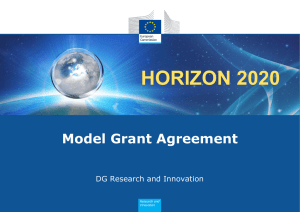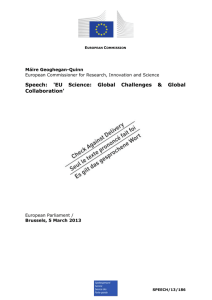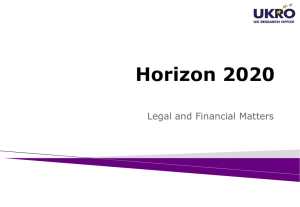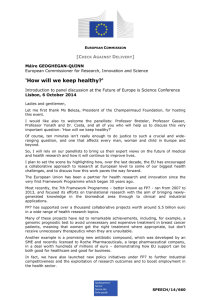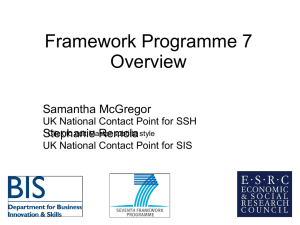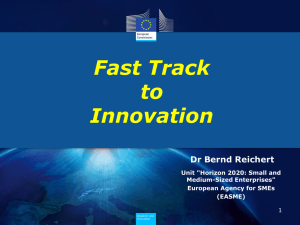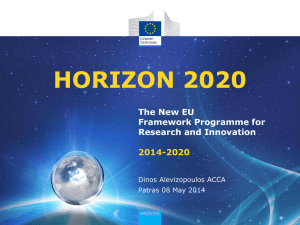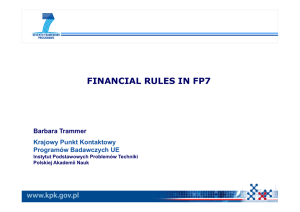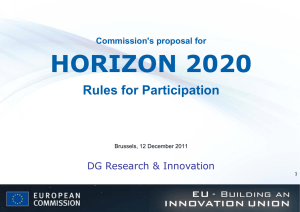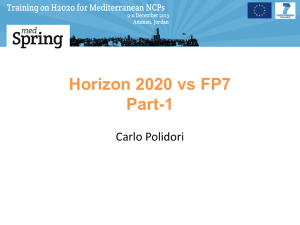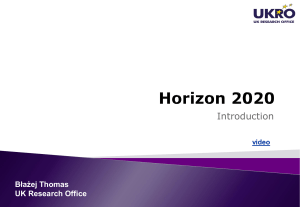H2020 - Financial Issues
advertisement
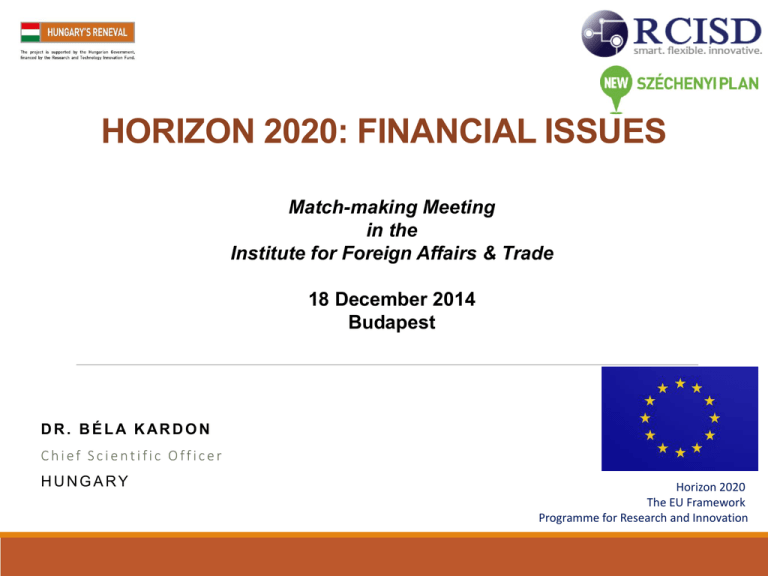
HORIZON 2020: FINANCIAL ISSUES Match-making Meeting in the Institute for Foreign Affairs & Trade 18 December 2014 Budapest DR. BÉLA KARDON Chief Scientific Officer HUNGARY Horizon 2020 The EU Framework Programme for Research and Innovation I. Simplification and Coherence Main Principles •A single set of rules •A single funding rate •A single indirect cost model •Further simplification efforts A single funding rate FP7 Maximum reimburseme nt rates Research and technological development activities (*) Network of excellence 50% 75% (**) Collaborative project(****) 50% 75% (**) Coordination and support action Demonstrati on activities Other activities 100% 50% 100% 100% (***) (*) Research and technological development includes scientific coordination. (**) For beneficiaries that are non-profit public bodies, secondary and higher education establishments, research organisations and SMEs (***) The reimbursement of indirect eligible costs, in the case of coordination and support actions, may reach a maximum 7% of the direct eligible costs, excluding the direct eligible costs for subcontracting (****) Including research for the benefit of specific groups (in particular SMEs) A single funding rate One project = One rate For all beneficiaries and all activities in the grant. Defined in the Work Programme: ‒ Up to 100 % of the eligible costs; ‒ but limited to a maximum of 70 % for innovation projects (exception for non-profit organisations - maximum of 100%) ‒ Specific reimbursement rates for programme co-fund actions Personnel costs Wider acceptance of average personnel costs (now under unit costs) Broadening the basic conditions for acceptance of average personnel cost accounting practices. Acceptance of supplementary payments for non-profit organisations of up to 8000 Euro/year/person Simplifying participation for SMEs Providing in the Rules for a unit cost system for SME owners and physical persons without a salary. …and more in the Horizon 2020 Grant Agreement The Grant Agreement will add further elements of simplification regarding personnel costs like simplified provisions on productive hours and clear minimum rules on time-recording. Single indirect cost model 20% ? 60% ? FP7 Real ? Single model: 25 % Flat Rate Simplified? Unique method - aiming at simplifying project management and reducing recurrent errors New funding model: what impact on the EU contribution? An example: FP7 Majority of HES & RTOs Direct costs Indirect costs Total costs Flat-rate (60%) 100 60 160 100/25 Funding Direct costs Indirect costs Total costs 100 25 125 % EU EU contribution contribution 75% € 120 % EU EU contribution contribution 100% € 125 Controls and Audits Financial viability Restricted to coordinators for projects ≥ €500 k€ Audit certificates Only for final payments/per beneficiary /for actual costs ≥ €325 000 € Optional Certificates on average personnel costs Provisions in Horizon 2020 Regulations! Ex-post audits Commission's audits up to two years after payment of the balance Audit strategy focused on risk and fraud prevention Guarantee Fund Continuity with FP7 Forms of funding (1) What is continued? ◦ Use of Grant Agreements ◦ Actual costs Forms of funding (2) What is new? Specific provisions targeting innovation: • pre-commercial procurement • procurement of innovative solutions • inducement prizes Financial instruments: • a debt financial instrument, • a financial instrument providing equity finance for R&I, etc. Possibility of output-based grants (lump-sums per project) Enhanced use of other lump-sums, flat rates and unit costs Types of Actions – Research/Innovation (1) Research and Innovation Actions – NO RfP definition but description in the WP annexes They are actions with Research and Development activities as the core of the project intending to establish new scientific and technical knowledge and/or explore the feasibility of a new or improved technology, product, process, service or solution - may include basic and applied research, technology development and integration, testing and validation on a small-scale prototype in a laboratory or simulated environment - may contain closely connected but limited demonstration or pilot activities aiming to show technical feasibility in a near to operational environment • 100% funding rate Types of Actions – Research/Innovation (2) "Pure" Innovation Actions – RfP definition "'Innovation action' means an action primarily consisting of activities directly aiming at producing plans and arrangements or designs for new, altered or improved products, processes or services. For this purpose they may include prototyping, testing, demonstrating, piloting, large-scale product validation and market replication„ • 70% funding rate (100% for non-profit legal entities) Types of Actions – Research/Innovation (3) Overlaps 'prototyping', 'testing', 'demonstrating' and 'piloting' not specific to innovation activities; they are also used to describe research and development activities (100% funding) • In the case of a Research and Innovation action, these activities are undertaken on a small scale prototype, in a laboratory or simulated environment • Innovation projects may include limited research and development activities. • Type of project expected, funding and Technology Readiness Level scale indicated in the WP topics Types of Actions – Coordination and Support Coordination and Support Action Actions consisting primarily of accompanying measures such as standardisation, dissemination, awareness-raising and communication, networking, coordination or support services, policy dialogues and mutual learning exercises and studies, including design studies for new infrastructure and may also include complementary activities of strategic planning, networking and coordination between programmes in different countries. • Substantially similar to FP7 THANK YOU FOR YOUR ATTENTION E-MAIL: b ka rd o n @ rc i s d . e u
